Sales of dietary supplements, including vitamin C, have reached record figures all over the world. Dealers have made us believe of numerous food supplements that it is not worth beginning the day without them. Let us see just the most popular ones: magnesium, vitamin K2, zinc, omega-3, coenzyme Q10, and flavonoids, or if we cannot decide, then multivitamin.
Vitamin C is different in so much as we have known it ever since childhood; it is an inherent part of our national pride thanks to Albert Szent-Györgyi, and even those having reservations about the pill-based health conception show a positive attitude to it. People generally think that vitamin C taken in tablets must certainly have some positive effect: it prevents cold and flu; it strengthens the immune system, and so on. Many non-professionals are convinced that vitamin C can prevent cancer, or when cancer occurs, intravenous vitamin C will definitely help.
It is good to know that the scientific literature provides guidance on the question whether all this is true or not. Those who write articles published in popular natural medicine journals and esoteric or women’s magazines for non-professional readers are not scientists. When an article you are reading begins with the popular phrase “According to scientists…” and ends with an empty conclusion, the author most probably was not a scientist and he must have had problems with the interpretation of the original scientific paper. And, regrettably, some experts see nothing in vitamin C but simply a business opportunity. For them the most important thing is instead of scientific truth the number of pills sold, and in this case, it is all the same if they are business-minded or act in accordance with their conviction. All this has led to the situation that much more false than true information related to vitamin C pop up on the pages of newspapers intended for non-professional readers. Now let us see what science says about the connection between vitamin C and cancer. You may find it particularly difficult to go through this article, but I am confident that when you get to the end of it, you will think it was worth the effort.
The main idea in this article is briefly that although a naturally occurring high vitamin C level protects against cancer, there has been no scientific proof so far to demonstrate that artificially produced vitamin C is able to do the same. In the same way as there is no evidence indicating that artificial vitamin C is entirely harmless when applied in cancer therapy. Nonetheless, the groups of people living a life free of diseases, their methods of having access to vitamin C, and taking an evolutionary perspective may lead to a solution.
Where does the notion that vitamin C is effective in tumorous diseases come from?
One can find even big names among the apostles of vitamin C. Those great men, however, earned their fame for research they did in some other fields. American biochemist Irwin Stone is famed for his food preservative work: he was the first to use vitamin C in the food processing industry as a preservative. Later, he was one of those to suggest that vitamin C could help prevent colds. He also wrote a book about the relationship between vitamin C and diseases, although he never researched the subject on its own. Stone greatly influenced the twice Nobel Prize winning chemist Linus Pauling. Just like in the case of Stone, Pauling did not become famous for research in medicine or physiology, though his Nobel Prizes made a marked impact on everybody. Pauling improved Stone’s theory and thought vitamin C to be effective against cancer and even HIV. However, these concepts remained theoretical, too, and, in the absence of substantial evidence, the medical society did not accept them. Nevertheless, Pauling’s views on vitamin C continue to enjoy great popularity in the form of orthomolecular medicine among a small minority of supporters of alternative medicine. Despite the fact that his name is associated with vitamin C, Albert Szent-Györgyi was awarded the Nobel Prize for his scientific results concerning cell respiration, and not for vitamin C research. His eminent merit with respect to vitamin C is that he was the first to isolate it. Though he was convinced that vitamin C is particularly important for health and took it in large doses himself, he did not conduct any clinical investigations associated with vitamin C and he, unlike Pauling, refrained from making strong statements about the relationship of vitamin C and cancer therapy.
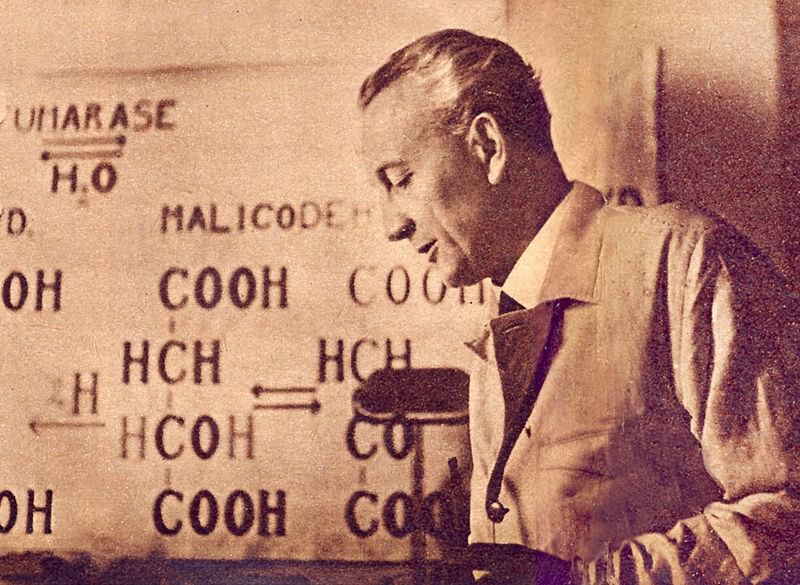
Albert Szent-Györgyi lecturing in front of a detail of the Szent-Györgyi-Krebs cycle named after him. Pesti Napló illustrated supplement, October 31, 1937
Szent-Györgyi, contrary to Pauling’s orthomolecular approach, which emphasized individual components, regarded the biological systems, and the links to nature as a whole, in their complexity and focused on the higher level organizing principle. I dare say that his perceptions anticipated the principles of evolutionary medicine, which could introduce entirely new concepts into medical practice particularly in cancer therapy and in curing autoimmune diseases.
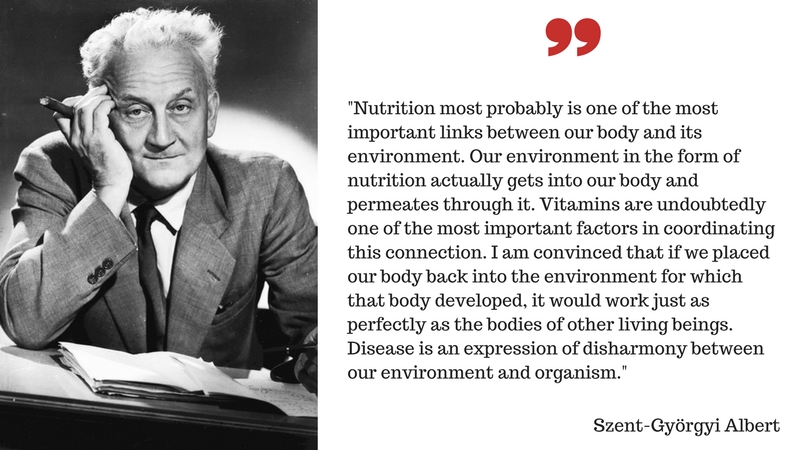
Does vitamin C prevent or cure cancer?
Four, so-called randomized controlled trials were conducted beginning from 1985 to find out if regularly taken vitamin C can prevent the development of tumours, or once cancer develops, if it can help prolong survival. The term ‘randomized’ means that these trials involved two groups of people: one group received vitamin C and the other did not. ‘Controlled’ means that the factors that may have still distinguished the two groups, e.g. smoking or alcohol consumption, were statistically controlled. The biggest trial involved 14,000 people, who were monitored for ten years. This trial, however, and the other three, too, showed the same result: vitamin C does not prevent the development of cancer, nor is it effective in cancer treatment, that is, it does not prolong survival in cancer patients.
What about intravenous vitamin C?
Advocates of vitamin C believed what they could not achieve with lower doses of vitamin C will succeed with larger doses. Vitamin C taken orally over a certain dose, however, is not absorbed by the body satisfactorily, that is, no matter how much more tablets one takes over a certain limit, it will not actually raise the blood level of vitamin C. To be sure, what they were hoping for was that high levels of vitamin C in the blood would cause toxicity to cancer cells. Consequently, they adopted a new approach and by bypassing the intestinal tract, began to administer vitamin C intravenously. Intravenous vitamin C then resulted in unnaturally high blood levels that were 30 to 70 times the normal value. Pauling and a physician, Ewan Cameron, reported their results regarding intravenous vitamin C in 1976. They used the therapy with 100 patients with terminal cancer and found that in the case of patients treated with vitamin C the survival time was three times longer than in the case of the historic controls. Historic control meant that the patients in the control group were chosen for comparison with the subjects treated with vitamin C subsequently, which made the study very much doubtful. Vitamin C sceptics, however, seized the opportunity and immediately challenged the test. A few years later, a physician by the name of Moertel came out with the result of an experiment at Mayo clinic, which ran counter to that reported by Pauling and Cameron: he found that vitamin C did not prolong the life of cancer patients. This was then a good excuse to defame Pauling and Cameron, which was not fair either as in Moertel’s experiment vitamin C was given orally, not intravenously, and therefore it cannot be said that it was a precise repetition of Pauling’s test.
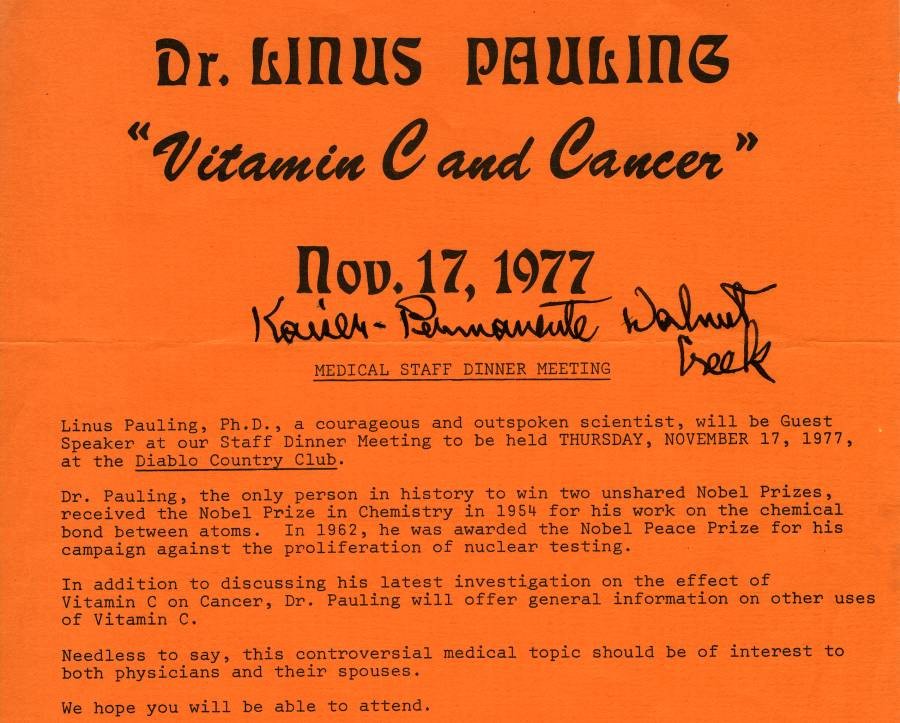
Flyer for "Vitamin C and Cancer," a lecture by Linus Pauling, 1977. Source: http://scarc.library.oregonstate.edu/coll/pauling/images/1977s2.9-900w.jpg
The relatively few investigations with respect to intravenous vitamin C so far were all concluded with negative results, i.e. they did not show an extension of survival time. There was among the investigations a randomized controlled trial performed among women with ovarian cancer parallel with chemotherapy. Half of the group received intravenous vitamin C for 12 months, and the other half received placebos. Although fewer side effects were reported in the vitamin C group, the trial did not show any difference as to survival time between the two groups by the end of the 12-month term. At least two additional group tests were also carried out, where intravenous vitamin C did not prolong survival in either of them. Alternative cancer therapists prejudiced in favour of vitamin C often cite one of these trials to confirm that intravenous vitamin C reduces the size of tumours. It was indeed found in the trial in question that the size of tumours somewhat decreased as a result of the treatment, it, however, did not improve the patients’ very short survival time.
Higher blood levels of vitamin C are associated with a lower risk of cancer
The above statement appears at first sight to contradict all other findings described before. All studies made on the subject have demonstrated that a relationship exists between low blood levels of vitamin C and the risk of developing cancer. The lower the blood level of patients who had already developed cancer was, the sooner they died. Thus, it seems that high blood levels of vitamin C offer a protection against cancer. To be sure, this only applies to naturally high vitamin C levels, because, as we have seen before, artificially produced vitamin C supplements or intravenously administered vitamin C do not improve the chances of cancer patients. Alternative cancer therapists and vitamin gurus like to refer to these scientific results when trying to sell their tablets – but they are wrong. It is a basic rule of research methodology that correlational studies do not lead to causal conclusions. Causal conclusions can be drawn from interventional studies only. Nevertheless, as we have seen before, these interventional studies all produced negative results. Thus, the answer to the question why vitamin C is ineffective if taken as a supplement is that evolution built out the natural route of vitamin C in the human organism during millions of years. When we take vitamin C as a supplement, we usually ignore our nutritional environment and the multitude of interactions that are present in our organism. Nor do we take into account important facts like, for instance, that vitamin C is actually a two-faced molecule and in certain environments, it does not behave like an antioxidant but rather like a prooxidant leading to the emergence of reactive free radicals. That is, it causes something against which we initially wanted to protect ourselves by taking vitamin C. Vitamin C supplementation by tablets or intravenous injections cannot reproduce the method of natural access to vitamin C in the form of nutrition. Although most studies describe the taking of vitamin C pills as being “relatively” safe, no targeted investigations exist to prove that it is actually true. At the same time, some epidemiological examinations have provided evidence to the effect that taking vitamin C for years promotes, even if to a small extent, the evolvement of certain types of tumour.
Since when do we know the vitamin C tablet?
The first vitamin C tablet was put on the market in 1934, and since the 1950s, increasing masses of people have been buying vitamin C. In the USA at present, almost half of the female population and one third of men regularly take vitamin C. But as the proportion of vitamin C takers has been steadily growing all around the world, what is the incidence of cancer like? It is also growing!
Do some people enjoy protection against cancer?
Yes, some people do, but we won’t find them in the countries of Western type civilization. Nor do we have to seek them in India or Japan, or in Tibet’s Buddhist monasteries. However, the hunter-gatherer communities living a nomadic life in various distant parts of world are unfamiliar with many diseases, among them cancer, that are decimating the Western population. This is no anecdote but a fact well documented by medical anthropologists. A scientific survey of these communities did not reveal any tumorous diseases either. One of the best known of the surveys is attached to the name of the Swedish general medical practitioner Staffan Lindeberg, who conducted a study of a group of people leading a close-to-nature life on Kitava Island in Papua New Guinea from the point of view of disease. He finally arrived at the conclusion that the Kitava people, similarly to other communities that remained isolated from other civilizations, are entirely free of these chronic diseases, including cancer. For Inuit, as was found by anthropologists studying their lifestyle, tumours and scurvy were unknown until around the 1960s, when they, too, fell victim to civilization and the health-destroying Western-type foods that it brought with it. Epidemiologists today are perplexed by the sad and distressing health statistics of Inuit.
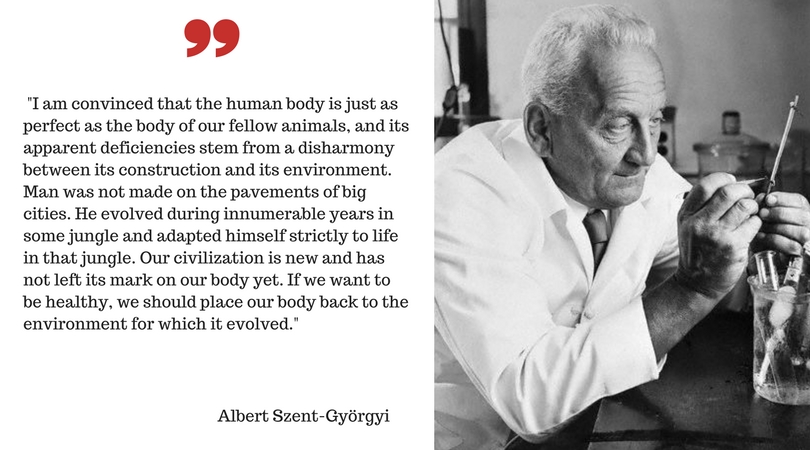
Inuit who retained their traditional life and the nomadic groups living in Asia and above the Arctic region, live, in sharp contrast to the official nutrition recommendations in the Western world, on a meat-and-fat based diet. They do not have access to carbohydrates at all, but they very much appreciate animal offal. They meet their vitamin C requirement mostly from livers, brains, and other kinds of offal. Mattak, made of the skin and blubber of marine mammals, a national meal Inuit highly esteem, is another important source of vitamin C for them. In the Carpathian Basin, it corresponds to pork belly with skin and smoked pork fat, or bacon. It is probably a long-standing tradition here in Hungary that on the occasion of pig slaughtering in autumn or early winter the participants eat the skin of the pig raw immediately after the slaughter, and utilize almost all parts of the animal. But other parallels can also be drawn. We also know of some traditions here, e.g. sausage filling, that resemble the habits shared by Inuit and hunter-gatherer communities living beyond the Arctic Circle, who store the cuts of meat from seal, whale, or reindeer in seal or reindeer stomach washed clean. We can recognize in the culture of hunter-gatherer societies, including Inuit culture, a positive symbol system related to vitamin-rich offal. Inuit have no words for diseases and have only three words referring to weariness or difficulties associated with old age. Yet, they know several dozen ways to utilize blubber.
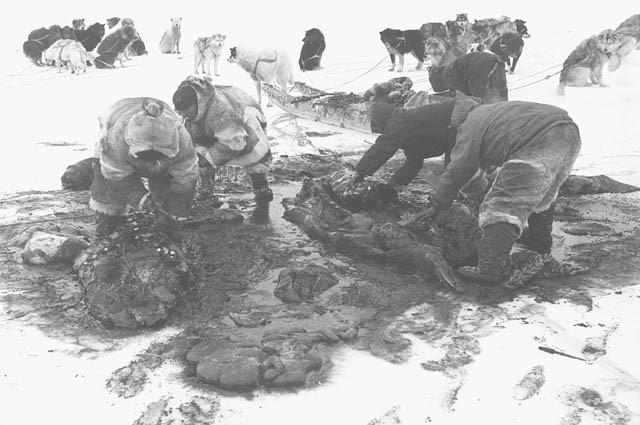
Inuit hunters processing walrus (1952-1953), Iglulik, Nunavut, Canada. (Richard Harrington / Library and Archives Canada / PA-129938)
Few people know that offal from grazing animals is a particularly rich source of not only vitamin D, but also vitamin C. This is no anecdote either, as demonstrated by existing studies to determine the vitamin C content of some animal organs. These studies established that the amount of vitamin C found in brain, the eyes, and the lymphatic organs are as much as 30 to 50 times the blood level. Almost everybody disregards the fact Albert Szent-Györgyi at first isolated Vitamin C from adrenal glands. At this point, it is an important biochemical finding that vitamin C and sugar, being structurally similar molecules, use the same receptor to enter cells, consequently, in the case of several cell types they compete with each other to get into cells. This phenomenon is called glucose-ascorbate antagonism. It means in practice that the more carbohydrates we eat and the higher our blood-sugar level is, the less vitamin C will be absorbed and utilized within the organism. Thus, what we must know is not just how much vitamin C a given nutrient contains, but also the kind of substances in it that might obstruct the utilization of vitamin C. Other matters alongside glucose that can block vitamin C absorption are flavonoids. For this very reason, the dietary supplements combining vitamin C with flavonoids available in organic stores fall into the category of biological nonsense.
As the immune cells desperately need vitamin C, our immune system is closely tied to our blood sugar level and the amount of carbohydrates we eat. A high blood sugar level and the fact that it obstructs the utilization of vitamin C harmfully affect the operation of the immune system; consequently, it contributes to the development and progress of tumours.
Like it or not, man – as regards his biological traits – is unequivocally part of the Animal Kingdom and the same rules apply to him as to the rest of the animal world. The animal species living today represent without exception the highest level of adaptation to their environment. We can take it for granted that no species have emerged over the course of evolution that would have to rely on artificial supplements in order to fend off disease. Only the environment and the nutritional type have to be found for which – as Albert Szent-Györgyi said – “this body was made”.

Written by: Zsófia Clemens
Scientific article: Zsófia Clemens, Csaba Tóth Csaba (2016) "Vitamin C and Disease: Insights from the Evolutionary Perspective," Journal of Evolution and
Health: Vol. 1: Iss. 1, Article 13.
The Paleomedicina approach is that of evolutionary medicine which has a wholly scientific basis. We do not use naturopathic methods and we distance ourselves from such methods. Our scientific papers published in international medical journals can be viewed here.
2018-02-03
 Rehabilitáció csak online elérhető
Rehabilitáció csak online elérhető
 E-mail: paleomedicina@gmail.com
E-mail: paleomedicina@gmail.com


